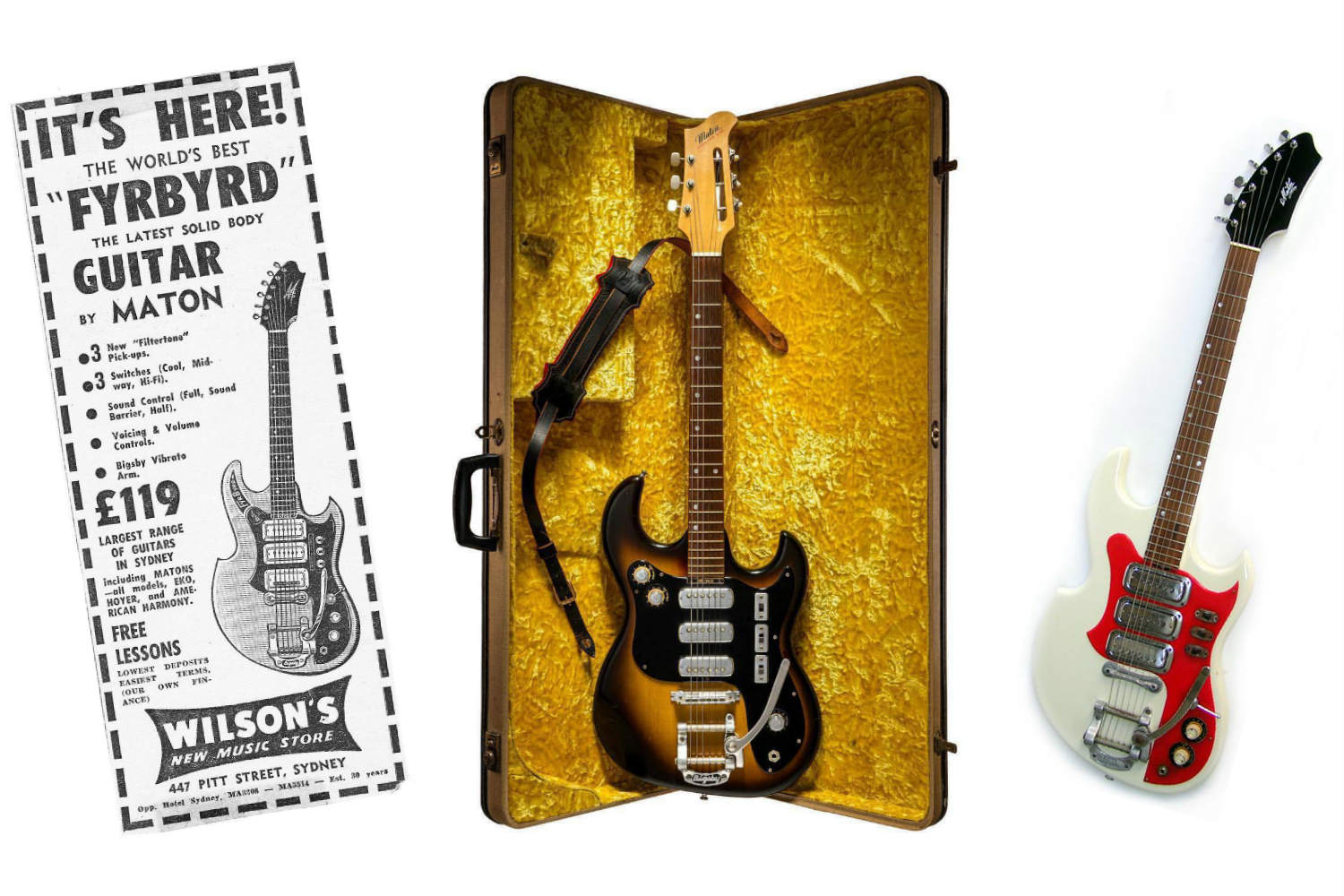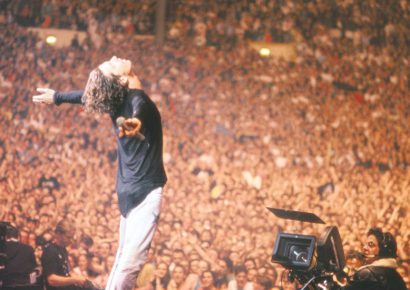Looking back on one of the most revered Antipodean birds of all time.
When Chuck Berry’s duck walk and Elvis’ shaking pelvis put rock ‘n roll on the map midway through the ’50s, Maton quickly followed suit.
Summary
- The Maton Fyrbyrd is considered by many vintage collectors as one of the best Australian guitars ever made.
- Produced between 1962 and the early 1970s, the Fyrbyrd encountered many stylistic evolutions as needs of guitarists changed in the ’60s.
- Fans of the offbeat instrument include Jay Watson, Neil Finn, Kim Salmon and more.
Explore our full range of features here.
Maton electric guitars
Led by the mighty mind of Bill May, the Australian manufacturers churned out a number of electric guitars between the 1950s and 1970s that captivated local players, eschewing the tried-and-true shapes of trailblazers like Fender and Gibson while delivering something more sleek than the bizarre designs pioneered by Japanese makers such as Teisco or Guyatone.
In an act of parallel evolution, Maton had emerged with something that was entirely their own: an aesthetic typified by jagged cutaways, knobs galore and a headstock that only a mother could love. This oddball combination only further added to the sense of Antipodean otherworldliness, already hinted at by the sound of the guitars themselves – scorchingly bright and twangy, with a searing ‘G’ string that could cut through plate glass.
These new Maton electrics were a call to arms for hundreds of homegrown garage acts that until now, had previously have to wait months, sometimes longer, in order to receive their new American or British made six-strings – often without much of a say on the colour or optional extras. God help you if you were left-handed.
George Harrison Maton
Not only were these new guitars accessible and moderately priced, but they were uniquely Australian: crafted from tonewoods such as Queensland maple and often named after the bizarre native birds that inhabited the mainland, Maton’s electric guitar output throughout this era was nothing short of historic. Guitars like the Wedgetail and Ibis, for instance, was just as unique as the birds that bore their namesake, while other models like the Flamingo, Wildcat and Sapphire couldn’t have been born from the minds of any other creator.
While it’s arguable that the Maton Mastersound – a guitar made famous by the likes of George Harrison, Murray Cook (aka The Red Wiggle) and a very young Tommy Emmanuel – may be the most visible of the early Matons, you don’t have to dig deep to discover the real iconoclast in the Maton catalogue from this era: the fabulous Fyrbyrd.
Hitting stores back in 1962, the first rendition of the FB620 Fyrbyrd couldn’t have been any further removed from the typical solid body guitars that were found in shops at the time. Decked out with three Filtertone pickups, a trio of switches to toggle between ‘HiFi’, ‘Mid-Way’ and ‘Cool’ tones, a trademark Maton Sound Control lever to adjust the output of the pickups and a Bigsby tremolo, the Fyrbyrd was designed to act as a true tonal chameleon.
The unique, jangly sound of the guitar can be heard across any number of early Aussie rock singles from the ‘60s, with Lithgow garage rock pioneers The Black Diamonds famously touting a pair of Fyrbyrds in a promotional clip for their raucous 1966 single ‘I Want, Need, Love You’. Further north, bands like The Rebels and The Grahams (the latter of whom featured three Fyrbyrds in the one band) brought the jangle to Queensland, flying the Maton flag and further helping to dispel any ideas that this was just a Victorian thing.
Sonics aside, it was the aesthetic silhouette of the FB620 that instantly captivated players more than anything else. On top of the vibrant finishes, crazy electronics and over-sized headstocks, these first-run Fyrbyrds were adorned with a quirky cutout on the upper horn that was colloquially referred to as a ‘shark bite’, and it’s this quirky embellishment which tends to cause a fuss among most collectors.
While these early Fyrbyrds weren’t exactly the most practical of guitars ever made – the three tone switches were subject to snapping if you strummed downwards hard enough, and some models fell prone to neck issues later in their lifetime – their quirky designs would nonetheless win them cult appeal among budding Australian garage and indie rockers, for the better part of 50 years, with Jay Watson (Tame Impala), Jules Douglas (The Panics) and Kim Salmon (The Scientists) being just some notable fans of the Fyrbyrd’s singular aesthetic.
After the initial run of Fyrbyrds hit the local market – in extremely limited quantities, which would inevitably help them achieve collectors status in the years to come – Maton followed up the FB620 with a model that sought to upgrade on some of the original’s shortcomings, adding in superior rocker switches to control the tone. However, these newer models did feature a significant lack of ‘shark bite’ in contrast to their predecessors, and as such, are found around the traps a little more frequently than their jagged siblings.
In 1965, Maton would give the Fyrbyrd a major overhaul with the release of the FB650, seeing them amend some of the original run’s more eccentric qualities even further to make for something almost entirely new unto itself. Gone were the radical offset contours of the FB620, with Maton edging closer and closer to the more streamlined body shapes found on popular Burns and Fender models of the era.
The tonal controls of the Fyrbyrd were also subject to several upgrades; the most notable of which was the absence of a Sound Barrier control in favour of two treble and bass expander switches, which were placed horizontally in order to stop over-eager garage rockers snapping them off during their panicked down-strums. Maton would also use a newly designed neck for the FB650 models, switching to a slotted 3×3 headstock and utilising a much slimmer neck profile compared to the chunky baseball bat necks possessed by the FB620 Fyrbyrd models.
However, the one that really turned heads was the FB1120: a twelve-string take on the Fyrbyrd, limited to a mere 120 pieces and deemed as one of the most coveted birds of the Maton roost. While the prospect of tuning a twelve-string guitar with a Bigsby sounds like an absolute menace on paper, in reality, the Fyrbyrd FB1120 is nothing but amazing – on top of holding tune, these models boast an incredibly inviting neck profile that makes navigating barre chords and riffs a breeze, while the pickups are perfect for nailing every kind of chimey tone under the sun.
One noted Maton fan who made special use of the FB1120’s jangly sound was none other than Crowded House’s Neil Finn, who still uses one on stage to this day, even with Fleetwood Mac.
Several Aussie guitar collectors deem this to be the sole reason these guitars are as pricey as they are on the collectors market, but the reality is that they are rarer than hen’s teeth. Other notable players of the Fyrbyrd 12 include Midnight Oil’s Jim Monginie, but to be honest, just owning one of these rare beauties is enough to make you notable in our eyes.
After the release of the FB1120 and FB620 models, Maton would once again overhaul the Fyrbyrd range in 1968 with the launch of the FB70; without a doubt the rarest Fyrbyrd to ever fly out of the Maton factory. Supposedly only limited to seven production models, the FB70 was decked out with a trio of humbucking pickups, a three-way pickup toggle switch and a new Japanese Bigsby tremolo, while the eccentric body of the guitar was radically reshaped to make it one of the most run-of-the-mill models to ever come from the Maton camp.
However, the FB70 was soon replaced by a newer Fyrbyrd variant that marked the return of the adored Sound Barrier control and two single coil pickups, with Maton also changing the position of the pickup toggle switch and adding an odd Fender-inspired headstock.
This second FB70 would form the blueprint for the final Fyrbyrd to come from the Maton factory in the 1970s: the mighty FBFX, an all-mahogany rock machine that reverted back to a body shape similar to the FB650 and added an Italian Eko tremolo arm. There’s few out there lucky enough to come across a final run Fyrbyrd in the flesh, but those who do are usually rather vocal in their praises for the FBFX: they’re mean axes for hard rock and garage stylings, and that slab mahogany body will sing for days with sustain.
In the time since, there have been a host of tributes and custom builds paying homage to the legendary original Maton Fyrbyrd. Electrical Guitar Company, Season Three and Harvester guitars are just some of the bespoke builders who have had a crack at the Sharkbite’s unique visual cues, combining them with all the playability of a modern guitar to result in the reissue that Maton simply refuse to make.
At the recent Maton: Australia’s Guitar exhibition at the Powerhouse Museum in Sydney, the Sharkbite Fyrebyrd was one of two Maton guitars forever immortalized in badge form, available for purchase at the museum’s gift shop. As they say in Hollywood – you know you’ve made it when you’re on a badge in a museum gift shop.
For a country sometimes lacking in discernible iconography, the Fyrbyrd serves as something of a friendly reminder of what it truly means to be Australian. The sense of parallel evolution, the gauche, acerbic charm, the subtle feeling of un-belonging and all of it presented in a voice as shrill and as dry as the midday sun. In terms of guitar icons, we could do much worse.
Read about Maton’s history here.

